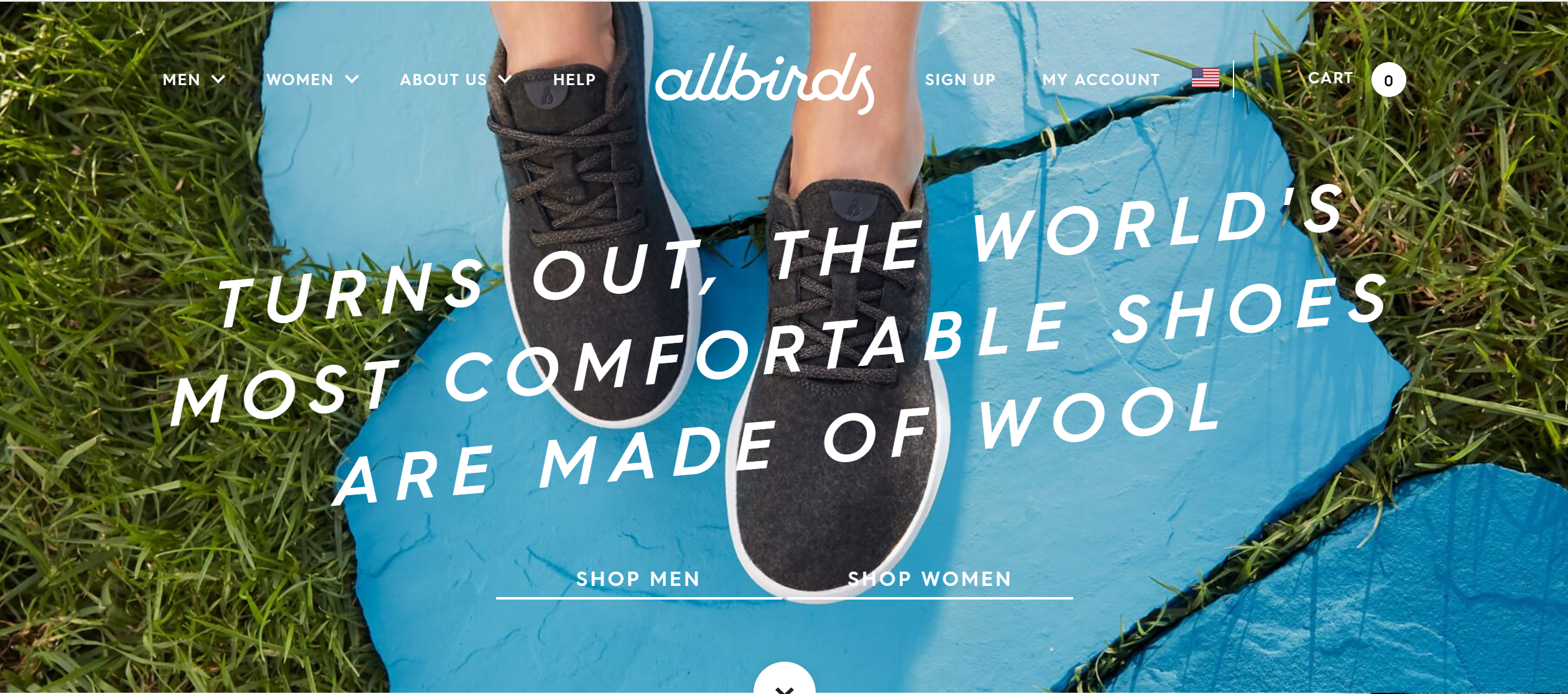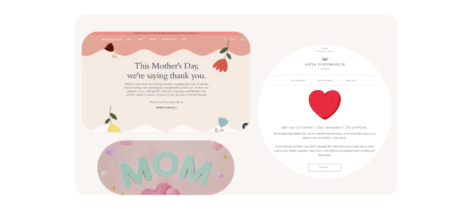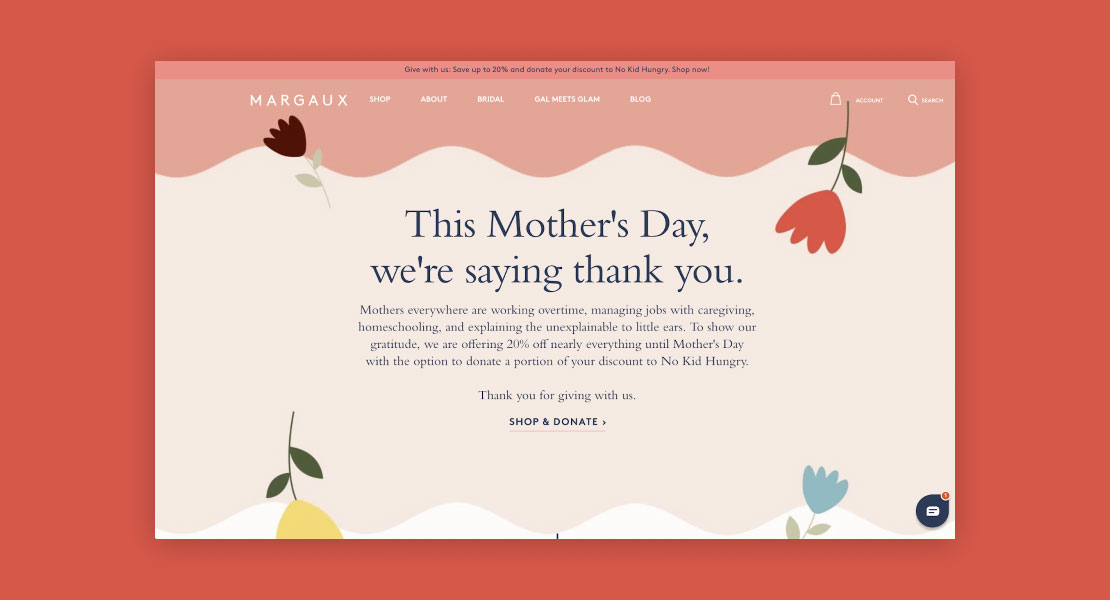In today’s hyper-connected and competitive business landscape, building a distinct brand identity is crucial for success. As consumers are bombarded with countless options, learning how to develop a brand voice has become an essential strategy for businesses to cut through the noise and stand out from the competition. A well-defined brand voice not only sets a company apart but also fosters trust, loyalty, and engagement among its target audience.
Join us as we explore five powerful ways to leverage your brand voice and differentiate your business in the market. The strategies and brand voice examples provided here are applicable to businesses of all sizes, from fledgling startups to well-established corporations to aspiring entrepreneurs.
How to Develop Brand Voice
Developing a strong and distinctive brand voice is a crucial step in establishing a unique identity and connecting with your target audience. Let’s go through some key considerations to guide you in developing your brand voice:
Understand Your Brand’s Personality and Values
Start by defining the personality and values that define your brand. Is your brand playful and energetic, or is it more serious and professional? What are the core values that guide your business? Understanding these aspects will help shape the tone and style of your brand voice.
Know Your Target Audience
To develop a strong brand voice that resonates with your audience, you need to understand their demographics, preferences, and communication style. Consider the language, tone, and vocabulary that will appeal to your target audience and align with their expectations.
Research Competitors
Conduct thorough research on your competitors’ brand voices. This will help you identify gaps and opportunities for differentiation. Analyze their tone, messaging, and overall brand positioning to ensure that your voice stands out and provides a unique value proposition.
Be Authentic and Consistent
Authenticity is crucial in developing a brand voice that resonates with your audience. Be true to your brand’s values and personality throughout all interactions. Consistency across all touchpoints, including website content, social media posts, emails, and customer service interactions, helps to reinforce your brand voice and build trust with your audience.
Test and Refine
Continuously test and gather feedback on your brand voice to ensure it aligns with your audience’s expectations and preferences. Monitor engagement, customer feedback, and market trends to identify areas for improvement and make necessary adjustments to your brand voice strategy.
How to Write Your Brand Tone of Voice Guidelines
The tone of voice brand guidelines are an essential component of developing and maintaining a consistent brand voice. These guidelines outline the specific tone, style, and language that should be used in all brand communications, both internal and external. Consider the following when creating your tone of voice brand guidelines:
- Your brand’s personality. Think about the personality traits that represent your brand. Is your brand playful, authoritative, friendly, or professional? These personality traits will set the foundation for determining the appropriate tone of voice.
- Tone variations. Consider the different situations and contexts in which your brand communicates. Outline how your tone should adapt in different scenarios while maintaining consistency with the overall brand personality.
- Language and vocabulary. Determine the appropriate language and vocabulary that align with your brand identity and resonate with your target audience. Define any specific jargon, technical terms, or industry-related language that should be used or avoided.
- Style and formatting. Consider the style and formatting elements that contribute to your brand voice. This includes aspects such as sentence structure, word choice, use of humor, use of metaphors or analogies, and overall writing style. Specify guidelines for punctuation, capitalization, and formatting to ensure consistency across all written communications.
- Dos and don’ts. Clearly outline specific examples of preferred language and tone, as well as examples of language or communication styles to avoid. This helps provide clarity to your team and ensures they understand the boundaries within which they should operate.
- Examples and guidelines. Provide concrete brand voice examples and guidelines that demonstrate the desired tone of voice in action. This can include sample sentences, hypothetical scenarios, or real-life examples that showcase the tone you want to achieve.
How to Leverage Brand Voice
Once you establish your brand voice, you need to learn how to effectively make it stand out from the competition and make a lasting impression on your target audience.
Reinforce With On-Site Promotions and Imagery
In the digital era, businesses have a limited window of opportunity to capture their audience’s attention. Therefore, it is increasingly important to create a consistent and compelling brand experience across all touchpoints. One powerful way to reinforce your brand voice is through on-site promotions and imagery.
Consistent use of your brand’s visual elements, such as logos, colors, fonts, and imagery, across your website creates a cohesive and memorable brand identity. When visitors encounter these familiar elements consistently throughout their journey on your site, it strengthens their recognition and association with your brand. This recognition builds trust and helps your audience differentiate you from competitors.
Moreover, on-site promotions and imagery allow you to create a cohesive brand experience for your audience. Whether it’s through banners, sliders, or pop-ups, you can effectively communicate your brand’s values, unique selling propositions, and key messages. The consistent brand experience builds credibility, encourages engagement, and fosters a sense of familiarity with your audience.
What is more, using visuals and messaging that reflect your unique brand voice, you create a memorable and differentiated experience for visitors. This differentiation helps your brand stand out in the minds of consumers, increasing the chances of capturing their attention, building brand loyalty, and ultimately gaining a competitive edge.
Thoughtfully designed on-site promotions and imagery can also drive engagement and conversions. You can direct website users toward desired behaviors, such as making a purchase, signing up for a subscription, or sharing material on social media, by strategically placing enticing imagery and messaging in crucial parts of your website. When your brand voice is consistently reinforced through these elements, it instills confidence and prompts users to take action, ultimately leading to increased conversions and business growth.
1. Reinforce with on-site promotions & imagery
An easy way to start converting and keeping your message clear is by running onsite promotions to reinforce your brand. A great example of that is Allbirds.
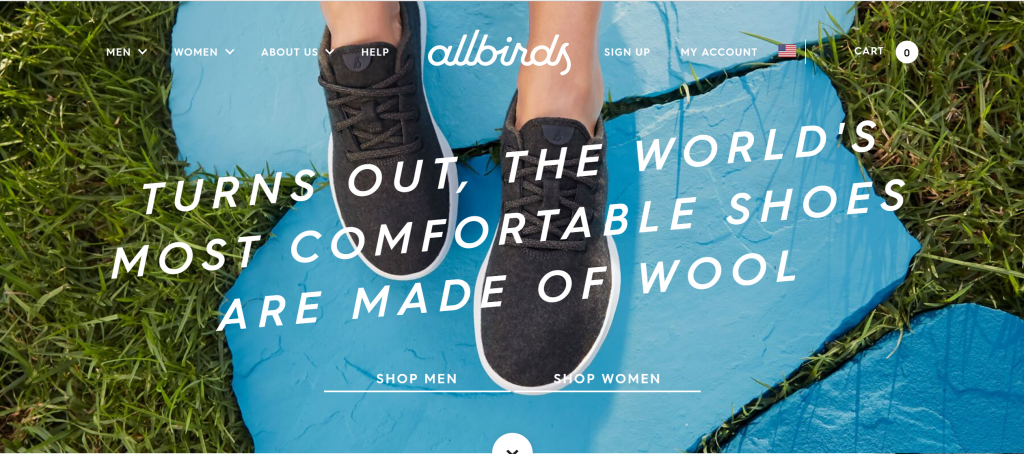
Powerful hero images as headers with flashy, bold text are their bread and butter. Allbirds prefers to take a casual feel, they’re light on the copy and personalize their message to consumers.
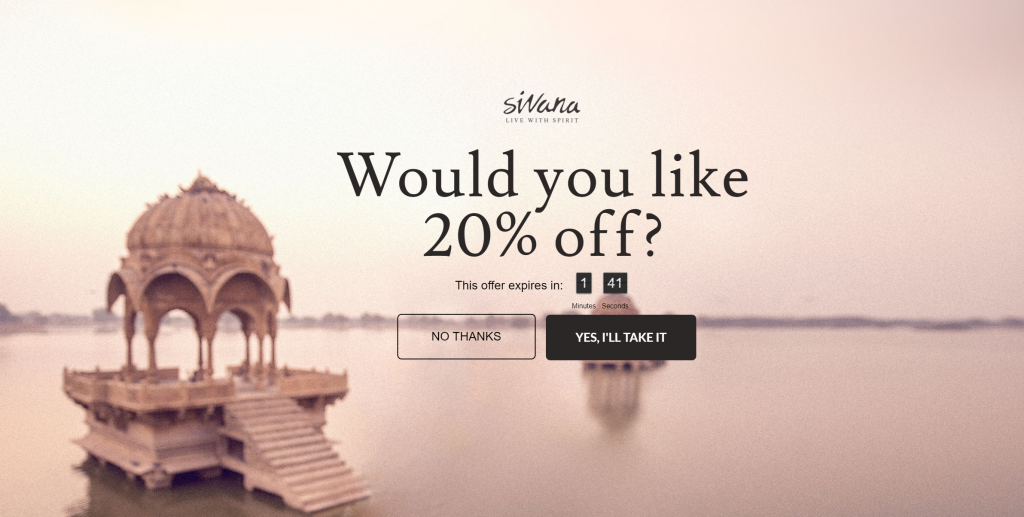
SivanaSpirit is a great example of promotions that mirror and reinforce brand voice. This Justuno client is a small, family-owned mindful lifestyle business located in CA. Reflecting their specific brand voice, Sivana Spirit employs a serene landscape as imagery for their full-screen promotion, keeping their motif going. Calm, mindful, and clean.
2. ‘Visualize’ your brand

Just like a person’s style of clothing and appearance make a lasting impression, your brand’s visual elements create a memorable impact on your audience. Each element, whether it be the color scheme, typography, or design choices, affects how your brand is seen overall.
Take into account the impact you wish to have and the feelings you want to arouse. Reflect on your target audience and their preferences. You can create a brand that engages customers on a deep level and is aesthetically beautiful by paying special attention to these factors.
Consistency is essential in visualizing your brand. It ensures that your brand identity remains cohesive across all touchpoints. Imagine a scenario where your brand is depicted in a refined and elegant manner, yet your website features a casual and playful design. Such inconsistency can confuse your audience and dilute your brand’s impact.
Align your brand’s visual representation with its intended personality, you create a cohesive and memorable brand experience. When your audience encounters consistent visual elements, they develop a stronger recognition and association with your brand. This consistency fosters trust, builds brand loyalty, and reinforces your brand’s values and messaging.
3. Spice up your social posting + interaction

Interacting with your consumers is big for e-commerce. Many things can go wrong whilst shopping online, from deliverability to product quality, so be proactive. Create visible social channels and encourage your consumers to interact with you and/or your support team when they have an issue. If a problem arises and you consistently address it with just a bit of your brand flavor, you’re going to build a loyal following.
When a problem arises, consistently addressing it while infusing your brand’s unique flavor adds a personal touch to the interaction. This personalization creates a sense of connection and builds trust with your audience. By showcasing your brand’s personality and values in your social interactions, you can differentiate yourself from competitors and cultivate a loyal following.
Don’t forget to inject a friendly and personable feel into your conversations with customers. For example, using GIFs can add a touch of humor and playfulness to your interactions, creating a positive and memorable experience. These small yet impactful gestures go a long way in fostering customer satisfaction and loyalty.
4. Use your brand voice in email marketing
Email marketing is still king of ROI Your emails are an extension of your brand voice as well, treat it like you’re speaking to your consumer, not selling to them.
Through email marketing, you have an opportunity to reinforce your brand identity and build recognition among your subscribers. Using your brand voice in email communications, including the language, tone, and style, allows you to create a cohesive and recognizable brand experience. When recipients receive an email that aligns with their previous interactions with your brand, it fosters a sense of familiarity, trust, and loyalty.
Moreover, email allows you to establish a direct line of communication with your subscribers, making it a prime opportunity to showcase your brand’s personality. Infusing your emails with your brand voice enables you to create a more relatable and human touch. This makes your audience feel valued and understood, increasing their engagement and receptiveness to your messages.
Using your brand voice in email marketing materials is also an opportunity to tell compelling stories and deepen your brand narrative. You may share experiences, stories, and insights with your subscribers that are consistent with your brand’s values by infusing your brand voice into your email content. This storytelling approach helps to build emotional connections, evoke engagement, and leave a lasting impression on your audience.
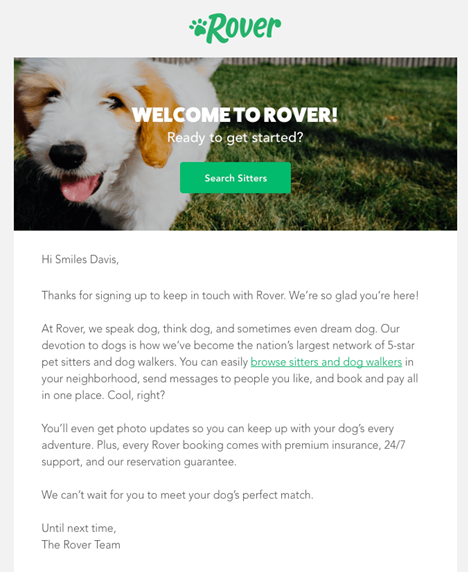
Here’s an example from Rover. With a pupper hero image and formatted text that is almost like a real handwritten letter, Rover makes it clear they’re thankful for the consumer’s engagement and keeps the dog-focused copy consistent. Rover and its community are absolutely crazy for all things to do with man’s best friend. Keeping their brand’s motive consistent, they incorporate the dog focused brand voice into their welcome emails.
5. Incorporate your brand with lifestyle imagery
Whilst not all brands can incorporate ‘lifestyle’ images, it is important to recognize the power of human-centric marketing in driving higher click-through rates and engagements. In the world of e-commerce, establishing trust with consumers is crucial.
By using lifestyle shots, whenever possible, you can effectively build that trust and help consumers envision themselves using your products. Lifestyle imagery creates a relatable and aspirational context, allowing your audience to see how your brand fits seamlessly into their lives. It evokes emotions, inspires desire, and fosters a stronger connection between your brand and potential customers. Incorporating your brand with lifestyle imagery allows you to create a visual narrative that resonates with your audience and enhances their trust in your offerings.

Allbirds incorporates moving footage along with their still imagery to invoke a certain ‘feeling’ when you think of their product. Without physically having the product in front of you, Allbirds still conveys the look, touch and fit of the product. Comfy, clean, attractive.

SivanaSpirit’s blog postings are all about their niche. As a family-owned business, the founders are perfectly in tune with their audience and are cognizant of what those consumers want to see, read and feel. “Power Crystals” and “Energy cleansing” are topics that SivanaSpirit’s buyers want to study and look into. Again, when a consumer thinks ‘healing’ and ‘spirit apparel’ Sivana Spirit will be the first thing to mind because their brand message is consistent and clear.
Lifestyle shots of their power crystals are also a huge win. People want to see how your product looks on them, and lifestyle shots give you that option.
Your brand is exactly that: your brand. Own the space and own your message.
Need some inspiration? Check out these branding and design examples from some of the top brands in e-commerce!
